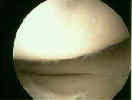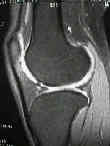- See:
- Discoid Meniscus::
- Types of Meniscal Tears;

- Discussion:
- in shape medial meniscus resembles a C, whereas lateral meniscus is more sharply curved and resembles an O
that is unclosed medially;
- lateral meniscus is much more of closed circle in uniform width from anterior to posterior;
- it has more of tibial surface than does medial meniscus & posteriorly is attached in intercondylar area to PCL via
ligaments of Humphry (the anterior menisco-femoral ligament) & Wrisberg (posterior meniscal femoral ligament);
- lateral meniscus is 4-5 mm thick, and has a width of 10-12 mm;
- the lateral meniscus bears upto 70% of medial compartment contact pressures;

- Soft Tissue Attachments:
- unlike medial meniscus there is no attachment to its adjacent collateral ligament (LCL);
- it is attached to the tibial plateau via the coronary (menisco-femoral) ligament, except in the region of the popliteal
hiatus;
- posteriorly the lateral meniscus is attached to the medial femoral condyle, via meniscofemoral ligaments;
- Partial Meniscectomy:
- menisci trasmit upto 70% of joint loads;
- partial menisectomy may increase peak loads upto 65% whereas total meniscectomy may increase peak loads upto 235%;
- the radiographic consequences of total menisectomy have been characterized by Fairbank and include: joint space narrowing,
squaring of the condyle, and ridge formation;
- in the report by Hoser C, et al, the authors studied the outcome of partial lateral meniscectomy of 31 knees in 29 patients whose knees
were otherwise normal;
- mean follow-up was 10.3 years;
- according to the Lysholm score, 14 knees were rated as excellent, four as good, five as fair and eight as poor, with a mean score of
80.5 points;
- radiologically, only one lateral compartment was classified as grade 0, eight as grade 1, nine as grade 2, 11 as grade 3, and two as
grade 4 according to Tapper and Hoover;
- no significant (p < 0.05) correlation was found between the amount of tissue resected and the subjective, clinical and radiological
outcome;
- although early results of lateral meniscectomy may be satisfactory, we have demonstrated that in the long term there was a high
incidence of degenerative changes, a high rate of reoperation (29%) and a relatively low functional outcome score;
- ref: Long-term results of arthroscopic partial lateral meniscectomy in knees without associated damage
- Lateral Meniscal Repair:
- if tear is w/in 3 mm of the periphery, it is considered vascular;
- area 3-5 mm from periphery is grey zone, & > 5 mm from periphery is considered avascular;
- unstable tears or tears within vascular zone that are > 7 mm are repairable;
- Misc:
- meniscal cysts:
- associated w/ lateral meniscal tears which extend into the capsule;
- in most cases, the meniscus tear is of horizontal cleavage type;
- pain located to the joint line;
- palpable and visible mass is usually noticed w/ the knee in extension (may diminish w/ flexion);
- mass is most often located at the joint line (anterior to the LCL), but may be located at distal aspect of iliotibial band;
- open excision is usually required;
- references:
- Arthroscopic treatment of cysts of the menisci. A preliminary report.
- Arthroscopic treatment of cysts of the lateral meniscus.
- Arthroscopic treatment of meniscal cyst.
Isolated lateral meniscectomy: a study of twenty-six patients with isolated tears.
Partial lateral meniscectomy in athletes.
The effect of lateral meniscectomy on motion of the knee.
Arthroscopic treatment of cysts of the lateral meniscus.
Lateral meniscal variant with absence of the posterior coronary ligament.


